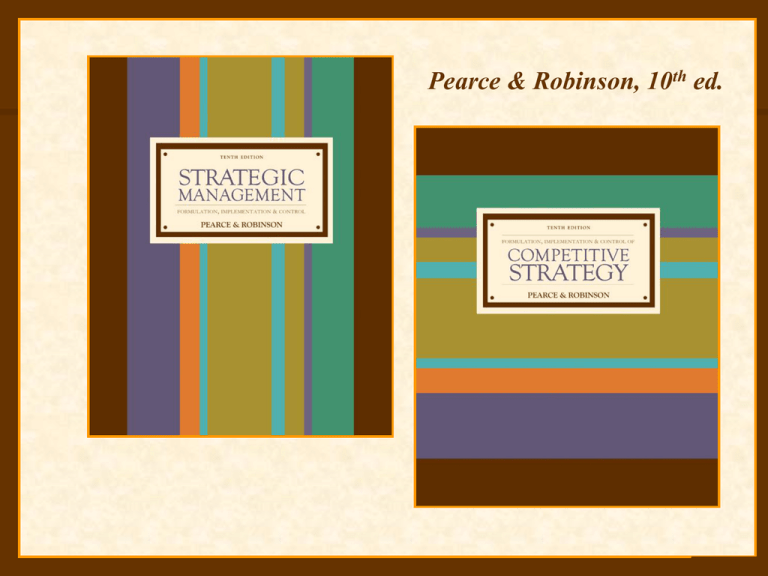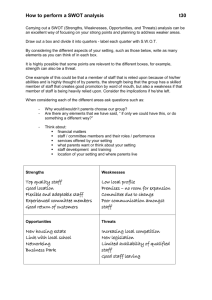
6-1
Pearce & Robinson, 10th ed.
Chapter 6
Internal Analysis
McGraw-Hill/Irwin
Strategic Management, 10/e
Copyright © 2007 The McGraw-Hill Companies, Inc. All rights reserved.
6-3
Learning Objectives
1. Understand how to conduct a SWOT analysis
2. Understand value chain analysis and how to use it
to disaggregate a firm’s activities
3. Understand the resource-based view of a firm
4. Apply four different perspectives for making
meaningful comparisons to assess a firm’s internal
strengths and weaknesses
5. Refamiliarize yourself with ratio analysis and
basic techniques of financial analysis to assist in
doing internal analysis
6-4
SWOT Analysis
A traditional approach to internal analysis:
SWOT is an acronym for the internal Strengths and
Weaknesses of a firm and the environmental
Opportunities and Threats facing that firm.
• SWOT analysis is a historically popular technique
through which managers create a quick overview
of a company’s strategic situation.
6-5
SWOT Components
•
•
•
•
An opportunity is a major unfavorable situation in a
firm’s environment
A threat is a major unfavorable situation in a firm’s
environment
A strength is a resource or capability controlled by or
available to a firm that gives it an advantage relative to its
competitors in meeting the needs of the customers it
serves
A weakness is a limitation or deficiency in one or more of
a firm’s resources or capabilities relative to its competitors
that create a disadvantage in effectively meeting customer
needs
6-6
SWOT Analysis Diagram
6-7
Limitations of SWOT Analysis
•
•
•
•
A SWOT analysis can overemphasize
internal strengths and downplay external
threats
A SWOT analysis can be static and can
risk ignoring changing circumstances
A SWOT analysis can overemphasize a
single strength or element of strategy
A strength is not necessarily a source of
competitive advantage
6-8
Value Chain Analysis (VCA)
•
•
•
The term value chain describes a way of looking
at a business as a chain of activities that transform
inputs into outputs that customers value
Value chain analysis (VCA) attempts to
understand how a business creates customer value
by examining the contributions of different
activities within the business to that value
VCA takes a process point of view
6-9
The Value Chain
6-10
Conducting a VCA
1. Identify activities
2. Allocate costs
• VCA proponents hold that the
activity-based VCA approach
would provide a more meaningful
analysis of the procurement
function’s costs and consequent
value added than the traditional
cost accounting approach
Traditional Cost Accounting VS
Activity Based Cost Accounting
6-11
Difficulty in Activity-Based
Cost Accounting
•
•
•
6-12
It is important to note that existing financial
management and accounting systems in many
firms are not set up to easily provide activity-based
cost breakdowns
Identify the activities that differentiate the firm
Examine the value chain
6-13
Resource-Based View (RBV)
1. RBV is a method of analyzing and
identifying a firm’s strategic advantages
based on examining its distinct
combination of assets, skills, capabilities,
and intangibles
2. The RBV’s underlying premise is that
firms differ in fundamental ways because
each firm possesses a unique “bundle” of
resources
3. Each firm develops competencies from
these resources, and these become the
source of the firm’s competitive
advantages
6-14
Three Basic Resources
1. Tangible assets are the easiest “resources” to
identify and are often found on a firm’s balance
sheet
2. Intangible assets are “resources” such as brand
names, company reputation, organizational
morale, technical knowledge, patents and
trademarks, and accumulated experience
3. Organizational capabilities are not specific
“inputs.” They are the skills that a company uses
to transform inputs into outputs
6-15
What makes a resource valuable?
4 Guidelines:
1. Is the resource or skill critical to fulfilling a
customer’s need better than that of the firm’s
competitors? Resurgence of Environmentalism
2. Is the resource scarce? Is it in short supply or not
easily substituted for or imitated?
3. Appropriability: Who actually gets the profit
created by a resource?
4. Durability: How rapidly will the resource
depreciate?
6-16
Elements of Scarcity
•
•
•
•
Short Supply
Availability of Substitutes
Imitation
Isolating Mechanisms:
–
–
–
–
Physically Unique Resources
“Path-Dependent” Resources
Casual Ambiguity
Economic Deterrence
6-17
Resource Imitation
6-18
Using RBV in Internal Analysis
It is helpful to:
• Disaggregate resources
• Utilize a functional perspective
• Look at organizational processes
• Use the value chain approach
6-19
Applying the Resource Based View
6-20
Making Meaningful Comparisons
•
•
•
Managers need objective standards to use when
examining internal resources and value-building
activities
Strategists use the firm’s historical experience as a
basis for evaluating internal factors
Benchmarking, or comparing the way “our”
company performs a specific activity with a
competitor or other company doing the same thing,
has become a central concern of managers in
quality commitment companies worldwide
Comparison with Success Factors
in the Industry
6-21
• The key determinants of success in an
industry may be used to identify a firm’s
internal strengths and weaknesses
• A strategist seeks to determine whether a
firm’s current internal capabilities represent
strengths or weaknesses in new competitive
arenas






